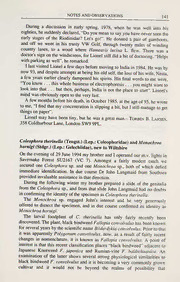
Coleophora therinella (Tengst.) (Lep.: Coleophoridae) and Monochroa hornigi (Stdgr.) (Lep.: Gelechiidae), new to Wiltshire PDF
Preview Coleophora therinella (Tengst.) (Lep.: Coleophoridae) and Monochroa hornigi (Stdgr.) (Lep.: Gelechiidae), new to Wiltshire
] NOTES AND OBSERVATIONS 4 ] During a discussion in early spring, 1978, when he was well into his eighties, he suddenly declared, "Do you mean to say you have never seen the eariy stages of the Riodinidae? Let's go!". He donned a pair of gumboots, and off we went in his trusty VW Golf, through twenty miles of winding country lanes, to a wood where Hamearis lucina L. flew. There was a doctor's sign on the windscreen, for Lionel still did a bit ofdoctoring. "Helps with parking as well", he remarked. I last visited Lionel a few days before moving to India in 1984. He was by now 93, and despite attempts at being his old self, the loss ofhis wife, Nesta, a few years earlier cleariy dampened his spirits. His final words to me were' "You know . . . this whole business ofelectrophoresis . . . you might want to look into that ... but then, perhaps, India is not the place to start". Lionel's mind was obviously open to the very last. A few months before his death, in October 1985, at the age of95, he wrote to me, "I find that my concentration is slipping a bit, but I still manage to get things on paper". Lionel may have been tiny, but he was a great man.- Torben B. Larsen, 358 Coldharbour Lane, London SW9 9PL. Coleophora therinella (Tengst.) (Lep.: Coleophoridae) andMonochroa hornigi (Stdgr.) (Lep.: Gelechiidae), new to Wiltshire On the evening of29 June 1994 my brother and I operated our m.v. lights in Savemake Forest SU2167 (VC 7). Amongst a fairly modest catch we secured one Coleophora sp. and one Monochroa sp., both of which defied immediate identification. In due course Dr John Langmaid from Southsea provided invaluable assistance in that direction. During the following winter my brother prepared a slide of the genitalia from the Coleophora sp., and from that slide John Langmaid had no doubts in confirming the identity ofthe specimen as Coleophora therinella. The Monochroa sp. engaged John's interest and he very generously offered to dissect the specimen, and in due course confirmed its identity as Monochroa hornigi. The larval foodplant of C. therinella has only fairiy recently been discovered. The plant, black bindweed Fallopia convolvulus has been known for several years by the scientific name Bilderdykia convolvulus. Prior to that it was apparently Polygonum convolvulus, now, as a result of fairly recent changes in nomenclature, it is known as Fallopia convolvulus. A point of interest is that this recent classification places "black bindweed" adjacent to Japanese Knotweed F. japonica and Russian-vine F. baldschuanica. An examination of the latter shows several strong physiological similarities to black bindweed F. convolvulus and it is becoming a very commonly grown cultivar and it would not be beyond the realms of possibility that 142 ENTOMOLOGIST'SRECORD, VOL. 108 15.V.1996 C. therinella could occur on this plant. I have given one extensive plant acursory examination with Coleophora cases in mind and a horrendous exercise it turned out to be. Finally, I would like to record the thanks ofmy brother and myselffor the help and advice generously given by Dr John Langmaid.- M.H. Smith, 42 BAH Bellefield Crescent, Trowbridge, Wiltshire 8SR. A late and an early Red Admiral Vanessa atalanta (L.) (Lep.: Nymphalidae) in Cambridge The last Red Admiral in my garden here in Cambridge was seen on 28 November 1995. Sitting having coffee in our sunroom at around 11.15 in the morning on 14 January 1996, a warm and sunny day, my wife said, "There's a butterfly on the outside windowsill." There was indeed and it was a very fresh-looking Red Admiral sunning itself, which it did for several minutes before taking off for a tour of the garden and eventually disappearing to explore adjacent gardens. A week or so previously the weather had been extremely cold and the temperature had gone down to -9°C which the butterfly must have survived.- Brian O.C. Gardiner, 2 Highfield Avenue, Cambridge CB4 2AL. Long-tailed Blue butterfliy Lampides boeticus (L.) (Lep.: Lycaenidae) in West Sussex during 1995 The year 1995 has already been widely noted as an exceptional year for immigrant insects. To date, however, I have seen no notification of sightings of the Long-tailed Blue butterfly L. boeticus. It therefore seems worth placing on record the occurrence of this noted migrant in Mr Christopher Johnson's garden at Chelwood Gate, near to Haywoods Heath in West Sussex, on 8 October 1995. The insect was captured on film and identified by Mr Johnson.- Max Elvidge, 69 Archel Road, London W14 9QL. More comments on the foodplants ofEuproctis chrysorrhoea L. (Lep.: Lymantriidae) Further to my communication on the hostplants of this lymantrid {Ent. Rec. 107: 276), I should like to confirm that Cornus sanguinea is used both as a foodplant, and as a site for the construction of the winter nest (hibemacula). & This plant is cited by Torossian, Torossian Roques (1988, Bull. Soc. Hist. Nat., Toulouse, 124: 127-174), solely as a larval foodplant. In addition, and perhaps more importantly, concerning my mention ofLaurus as a hostplant for this species, this shrub is also used as the site for the hibemacula. I located one small web on the former plant, and two large webs on the latter plant, in the Canning Town area ofeast London on 16 January 1996. - G. King, 22 Stoney Meade, Slough SLl 2YL.
